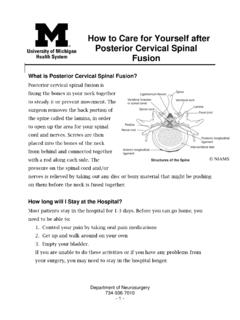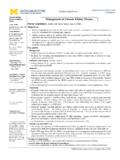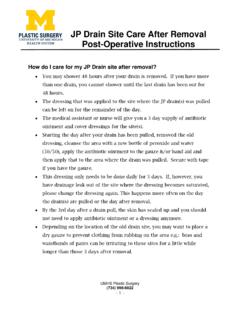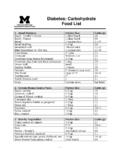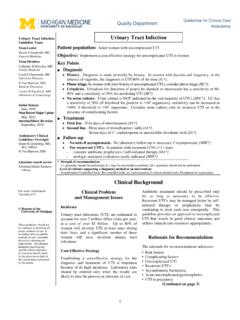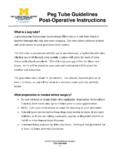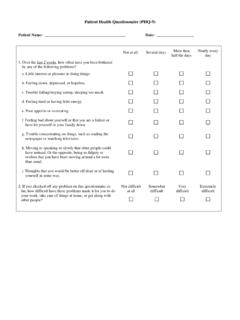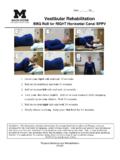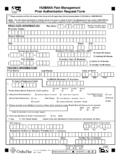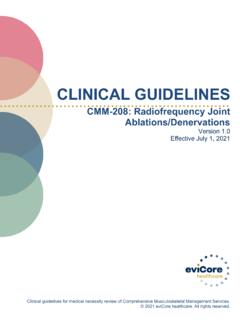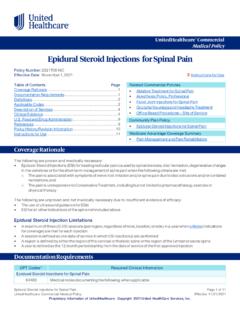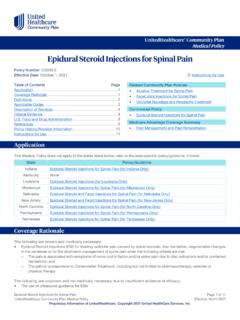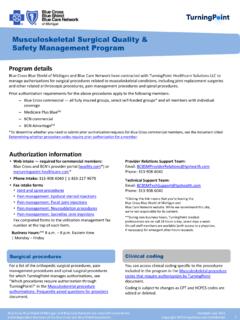Transcription of Preparing for Spine Injection Therapy
1 Preparing for Spine Injection Therapy Why do I need Spine Injection Therapy ? Your Health Care Provider is recommending Spine Injection Therapy to help relieve your back and neck pain. This will be in addition to other therapies such as medications and physical Therapy . The purpose of these injections is to reduce the amount of inflammation (swelling, pain, heat, redness, loss of body function) around the nerves thus reducing the amount of pain. The medications you will receive with the injections will include: an anesthetic - medication to numb the painful area.
2 A steroid - medication that prevents or reduces swelling and pain (anti- inflammatory). To reduce your discomfort during the Injection procedure, you will receive a numbing medication Injection prior to the placement of the needles. You will be lying on your stomach during the Injection procedure. We will use a low-dose x- ray (fluoroscopy) to help guide needle placement. What are the different types of injections and procedures? Below, is a brief description of the different types of injections we use to deliver pain medication as close as possible to the nerves in the painful area: Physical Medicine and Rehabilitation Spine Program 734-936-7175.
3 -1- epidural Injection : (picture on the right) epidural injections place 2. medications in your epidural space. This is the space alongside your spinal canal (not inside of it). Nerves from your spinal cord pass through this space. The medications will bathe those nerves. You must have a driver for this procedure. We will need to reschedule your Injection if you do not have a driver with you. Facet joint Injection : These injections place 2 medications into staff. the joints of your neck or Spine . You do not need to have a driver Si joint Injection : (picture on the with you.)
4 Left) deliver pain medications into the Sacroiliac joint that connects the hip bones. You do not need to have a driver with you. Hip joint Injection : deliver pain medication to the joint that connect your hip and femur bones (the femur is the bone in the center of the leg that extends from the knee with the hip). You will be lying on your side with your affected side up. For example, if we are injecting your left hip, then you will be lying staff. on your right side. You do not need a driver. Physical Medicine and Rehabilitation Spine Program Pre-Patient spinal Injection Instructions -2- Medial Branch/Genicular/Hip Block Injections: This is a test to see if your pain is coming from a specific nerve.
5 This Injection is similar to a facet joint Injection , but contains only the numbing medication. You will keep a pain score diary for the rest of the day and the following morning after receiving the Injection . You do not need a driver. Radiofrequency ablation: This is a procedure that uses radio waves and numbing medication to block the nerves that feel pain at the joint. The pain relief effects can last for a long time, but are not permanent. The procedure is similar to the Medial Branch Block but requires additional testing to ensure that the needle is near the nerve before numbing and ablating it.
6 You do not need a driver if you choose not to be sedated, but doctors often order sedation for this procedure. Please see the sections on sedation below. Discogram: This is a procedure to place dye into your disc(s) to help determine if a tear in the disc is the cause of your pain. A disc is the soft pad positioned in between each of the vertebrae of the Spine . You will receive intravenous antibiotics before this procedure to minimize the risk of infection. What should I expect if I receive sedation? This is conscious sedation. The medications we give to you will help you relax and reduce your anxiety.
7 You will still be awake for the procedure so we can ask you questions and hear your answers. What are my responsibilities with sedation? You must stop eating and drinking 6 (six) hours before your procedure. This includes gum, mints, water and coffee/tea. Take your morning medications with a small sip of water. You must have a driver who will check-in with you, and stay in the building while the procedure is underway. If you do not have a driver your sedation will be cancelled. We will monitor you for at least 30 minutes after the procedure before being discharged home.
8 Physical Medicine and Rehabilitation Spine Program Pre-Patient spinal Injection Instructions -3- What are the risks and complications for this procedure? Risks and complication are rare, but can still occur. You should understand, discuss, and accept these risks before agreeing to the procedure. They include, but are not limited to: infection nerve damage paralysis Injection failure or a need for further injections or additional procedures continued or worsening of symptoms/pain, medication reaction, dural leak (into the hole covering around the spinal cord.)
9 This may cause a spinal headache). leak of the medication into the spinal canal, nerves, or blood vessel. What do I need to do before the procedure? If you do not follow these instructions your procedure may be cancelled. Tell us if you are any on major blood thinners such as Coumadin, Xarelto , Plavix, Eliquis , Pradaxa , or others. o Contact the doctor who prescribed your blood thinner to ask for permission to stop taking it before you have the Injection . o Schedule your pain Injection procedure after your doctor gave their permission. o We will notify you when to stop and re-start your blood thinner.
10 Tell us if you have any allergies to contrast dye. If you do, we may give steroids to take before the procedure. Tell us if you are pregnant, or possibly pregnant. If so, you cannot receive steroid medications or be exposed to fluoroscopic X-rays. Tell us if you have been sick during the 10 days before the procedure. This includes: o colds o gastrointestinal illness or discomfort o dental sores, Physical Medicine and Rehabilitation Spine Program Pre-Patient spinal Injection Instructions -4- o skin infection, or any other type of infection. Tell use if you have taken antibiotics during the 10 days prior to the procedure.
